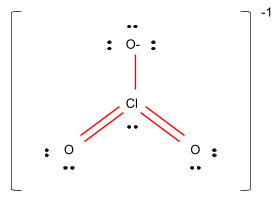
The shape of $Cl{O_3}^ - $ according to VSEPR model is-
(A) Planar triangle
(B) Pyramidal
(C) Tetrahedral
(D) Square planar
Answer
143.1k+ views
Hint: This question belongs to the chapter Chemical Bonding and Molecular Structure. This question demands us to find the shape of compound $Cl{O_3}^ - $, to state the structure we need to place the formula of hybridization. By placing all the required values, we can find our answer.
Complete step by step answer:
> Chlorate is a white crystalline, inorganic in nature. It is water-soluble. The material itself is noncombustible, but can form a very flammable combination with materials which are combustible, which can be explosive if the combustible material is very finely divided. Friction can ignite the mixture. Strong sulfuric acid contact may lead to fires or explosions. Spontaneous decomposition and ignition can result when mixed with ammonium salts. Long exposure to heat or fire can lead to an explosion.
The compound is $Cl{O_3}^ - $.
By placing hybridization formula, we get
$ \Rightarrow \dfrac{1}{2}$ (Number of valence electron on center atom + number of monovalent atom)
$ \Rightarrow \dfrac{1}{2}\left( {7 + 0 + 1} \right)k$ { here, 7 is the valence electron on chlorine, oxygen is divalent so monovalent 0, 1 is the charge gained}
$ \Rightarrow \dfrac{1}{2}\left( 8 \right) = 4$, so we get $s{p^3}$ hybridization.
4 bonds would have been made but it will be 3 bond pair and 1 lone pair
Figure –
So, the shape of the compound $Cl{O_3}^ - $ would be pyramidal.

Hence, it is clear that option B is the correct option.
Note: Chlorate is a monovalent anion derived from chloric acid deprotonation. It's a mere inorganic anion and oxoanion chlorine. It is a chloric acid conjugate base.
Complete step by step answer:
> Chlorate is a white crystalline, inorganic in nature. It is water-soluble. The material itself is noncombustible, but can form a very flammable combination with materials which are combustible, which can be explosive if the combustible material is very finely divided. Friction can ignite the mixture. Strong sulfuric acid contact may lead to fires or explosions. Spontaneous decomposition and ignition can result when mixed with ammonium salts. Long exposure to heat or fire can lead to an explosion.
The compound is $Cl{O_3}^ - $.
By placing hybridization formula, we get
$ \Rightarrow \dfrac{1}{2}$ (Number of valence electron on center atom + number of monovalent atom)
$ \Rightarrow \dfrac{1}{2}\left( {7 + 0 + 1} \right)k$ { here, 7 is the valence electron on chlorine, oxygen is divalent so monovalent 0, 1 is the charge gained}
$ \Rightarrow \dfrac{1}{2}\left( 8 \right) = 4$, so we get $s{p^3}$ hybridization.
4 bonds would have been made but it will be 3 bond pair and 1 lone pair
Figure –
So, the shape of the compound $Cl{O_3}^ - $ would be pyramidal.

Hence, it is clear that option B is the correct option.
Note: Chlorate is a monovalent anion derived from chloric acid deprotonation. It's a mere inorganic anion and oxoanion chlorine. It is a chloric acid conjugate base.
Recently Updated Pages
How to find Oxidation Number - Important Concepts for JEE

How Electromagnetic Waves are Formed - Important Concepts for JEE

Electrical Resistance - Important Concepts and Tips for JEE

Average Atomic Mass - Important Concepts and Tips for JEE

Chemical Equation - Important Concepts and Tips for JEE

Concept of CP and CV of Gas - Important Concepts and Tips for JEE

Trending doubts
JEE Main Exam Marking Scheme: Detailed Breakdown of Marks and Negative Marking

Electrical Field of Charged Spherical Shell - JEE

JEE Main Chemistry Question Paper with Answer Keys and Solutions

Geostationary Satellites and Geosynchronous Satellites - JEE Important Topic

JEE Main 2025: Conversion of Galvanometer Into Ammeter And Voltmeter in Physics

Introduction to Dimensions With Different Units and Formula for JEE

Other Pages
JEE Advanced 2025: Dates, Registration, Syllabus, Eligibility Criteria and More

NCERT Solutions for Class 11 Chemistry Chapter 5 Thermodynamics

NCERT Solutions for Class 11 Chemistry Chapter 7 Redox Reaction

NCERT Solutions for Class 11 Chemistry Chapter 8 Organic Chemistry

Number of sigma and pi bonds in C2 molecule isare A class 11 chemistry JEE_Main

JEE Advanced 2025 Revision Notes for Practical Organic Chemistry




